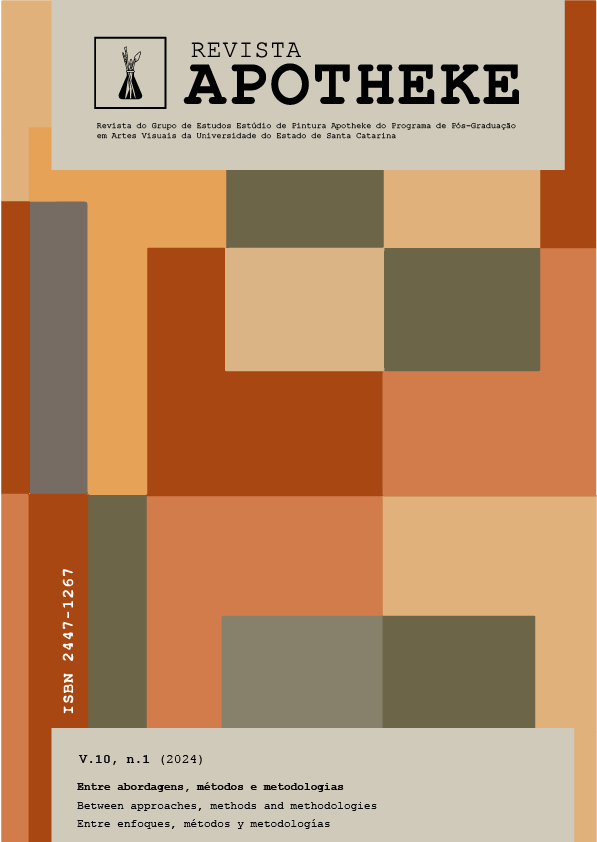Artist residency in the classroom: a possible experience?
DOI:
https://doi.org/10.5965/244712671012024137Keywords:
artist residency, artist’s book, teaching-learning, creation processesAbstract
This article intends to reflect on the lessons learned from an Extension Project entitled “Artist Residency” - proposed by a professor of an undergraduate curricular subject, at the Institute of Humanities, at Unilab (Universidade da Integração Internacional da Lusofonia Afro-brasileira) – based on the experience of one of the invited artists from the work “Livro-mobiliário, um livro de artista” and his creation processes. Thus, its objectives are: move some places and concepts concerning the field of arts and its performances; reflect on curricular subjects as spaces that are established as processes of knowledge with the human aspect; understand about a plastic experimentation of artist residency; and to present a practice of expanding perception and coexistence between academic and non-academic communities, with artistic languages. To this end, it experimented with diversified methodologies in the form of critical debates, didactic-artistic exercises, textual productions and elaborations of works of art presented at the end of the semester by students and invited artists. The “Artist Residency”, in this perspective, in addition to being an innovative proposal, sought to contribute to the understanding of teaching-learning process in the Brazilian public university as a place of exchange and mutual sharing of knowledge. The main theoretical contributions for this text were: BASBAUM (2013), BARTHES (2003), CARRIÓN (2011), DERDYK (2013).
Downloads
References
ALBUQUERQUE, Aline. Tipo Grito. Fortaleza: Litoral Press & Complexo Gráfico, 2021.
ASCOTT, Roy. Existe amor no abraço telemático. In: Arte, Ciência e Tecnologia – Passado, Presente e Desafios, Diana Domingues (org.). São Paulo: Editora Unesp, 2009. p. 305-318.
BARTHES, R. Como viver junto: simulações romanescas de alguns espaços cotidianos: cursos e seminários no Collège de France, 1976-1977. São Paulo: Martins Fontes, 2003.
BASBAUM, Ricardo. Manual do artista-etc. Rio de janeiro: Beco do Azougue, 2013.
BRYSON, B. Em uma casa – Uma breve história da vida doméstica. São Paulo: Companhia das Letras, 2011.
CARRIÓN, Ulises. A nova arte de fazer livros. Belo Horizonte: C/Arte, 2011.
DERDYK, Edith (Org). Entre ser um e ser mil: o objeto livro e suas poéticas. São Paulo: Editora Senac São Paulo, 2013.
FAVARETTO, Celso. Deslocamentos: entre a arte e a vida. Revista Ars, v.9, n.18, 2011. p. 94-109.
MORAES, Marcos. Residência artística: uma reflexão sobre os ambientes de formação, criação e difusão das práticas artísticas contemporâneas. In: Políticas para as artes: prática e reflexão (v.02). Rio de Janeiro: FUNARTE, 2014. P.14-42.
PROJETO PEDAGÓGICO CURRICULAR: CURSO DE BACHARELADO EM HUMANIDADES. Unilab, abril de 2019. Disponível em: https://unilab.edu.br/wp-content/uploads/2020/10/PPC-BHU-2019.pdf
RANCIÈRE, Jacques. A partilha do sensível: estética e política. São Paulo: EXO Experimental org.; Ed. 34, 2005.
SANTAELLA, Lúcia. Cultura e artes do pós-humano: da cultura das mídias à cibercultura. São Paulo: Paulus, 2003.
SCOVINO, Felipe; TJABBES, Pieter. Abraham Palatnik: a reinvenção da pintura. São Paulo: Art Unlimited, 2021.
VALENTE, André. GENTE I. São Paulo: Bebel Books, 2014.
Downloads
Published
How to Cite
Issue
Section
License
Copyright (c) 2024 Ícaro Lênin Maia Malveira, Jo A-mi

This work is licensed under a Creative Commons Attribution-NonCommercial 4.0 International License.
Copyright and Licensing Policy
Authors of works submitted to Revista APOTHEKE authorize their publication in both print and digital formats exclusively for academic purposes. Reproduction is permitted, provided that the source is properly cited. Authors confirm the originality, authorship, and unpublished status of their manuscripts.
Articles published by the journal are freely available and intended for academic and non-commercial use only. All copyrights are transferred to the journal. The content of signed articles reflects the views of their respective authors and not the official position of Revista Apotheke. The author(s) agree to always cite the following reference when republishing or referring to the content originally published in Revista Apotheke:
“This article was originally published by Revista Apotheke in volume (insert volume), number (insert number), year (insert year), and is available at: http://www.revistas.udesc.br/index.php/APOTHEKE/index”
It is the sole responsibility of the authors to obtain written permission for the use of any material protected by copyright law included in their articles. Revista Apotheke is not responsible for copyright infringements committed by contributors.
Authors retain copyright and grant the journal the right of first publication, with the work licensed under a Creative Commons Attribution-NonCommercial License (CC BY-NC):
-
Attribution (BY): Licensees are allowed to copy, distribute, display, perform, and create derivative works, provided that proper credit is given to the author or licensor, in the manner specified.
-
NonCommercial (NC): Licensees may use the material only for non-commercial purposes.
After publication, authors retain the rights to their work and may republish the text.



